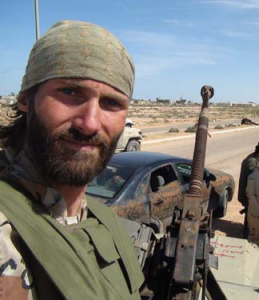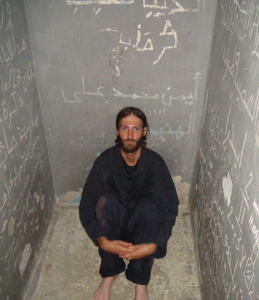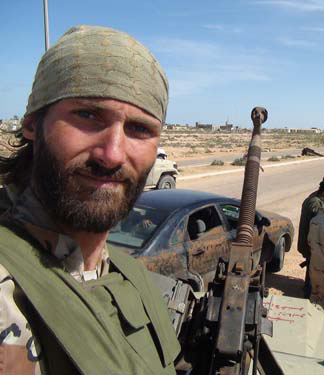
The cell was 3 feet by 7 feet. The only light came from a small pinhole in the ceiling, and the sole sounds were the screams of fellow prisoners as they were tortured. Seven years after graduating from Georgetown, Matthew VanDyke (GRD ’04) was trapped in a Libyan prison, captured as an enemy combatant against the regime of Muammar Gaddafi.
After six months in the prison, a loud commotion outside broke the solitude. VanDyke automatically assumed the worst.
“I was convinced they were guards coming to kill me,” he said.“I thought that they were upset by something that had happened in the war and were coming to kill me for revenge.”
But as the lock on his cell was busted open and the door clattered away, he realized the mob was wearing the same clothes as him. VanDyke took the chance to trust them enough to run away with them, following the group of men outside to the right of the prison and to his freedom.
The rest of VanDyke’s existence has been defined by that moment. An activist, news analyst, media commentator and freedom fighter,VanDyke spends his days incited by his time in that cell.
“I became committed to the cause of revolution,” he explained. “It has defined the cause of my work and my life.”
This experience serves as the main focus of VanDyke’s highly acclaimed second documentary, “Point and Shoot.” The documentary premiered at the Tribeca Film Festival last April, winning the Best Documentary Award. Produced with fellow filmmaker Marshall Curry, the documentary is a collection of footage VanDyke shot between 2007 and 2011 while travelling through the Middle East on his motorbike until his arrest by government forces in Libya. It is a powerfully moving and almost incomprehensible piece of film.
VanDyke entered Georgetown’s Security Studies Program convinced he would join the CIA and pursue a career in intelligence security. Although he received a job offer from the agency after his first semester, the Iraq War changed his mind. He quickly joined the anti-war movement on campus and turned down the job offer that went against his beliefs.
Armed with the SSP degree and “nothing to do with it,” VanDyke decided to make a radical choice. He decided to emulate Alby Mangels, an Australian filmmaker known for his adventure documentaries. On this trip, VanDyke became closer with those he met in the Middle East than his friends from back home. When fighting in Libya broke out against Gaddafi, some of these new companions complained about the lack of support they received from the international community.
“My friends were telling me about family members being arrested or disappearing or being injured. They would say to me things like, ‘Why doesn’t anybody help us?’ So I said I would be there.”
VanDyke travelled to Libya to fight against the government. On March 13, 2011, only a week after arriving in the country, VanDyke’s brigade was ambushed by Gaddafi’s forces. He has no memory of what happened next.
“I was knocked unconscious during the arrest, so I woke up in prison with a head injury and no memory of how I got there,” he said.
VanDyke was transferred to Tripoli and was later held captive in two different prisons, including the Maktab al-Nassar prison that is known as Libya’s “nightmare factory.” His mother and girlfriend approached many human rights organizations to ask where he was, and these institutions tried to pressure Gaddafi to reveal VanDyke’s location. However, the Libyan government refused to answer. It was many months until Gaddafi would even acknowledge that he had imprisoned VanDyke, and he never publicly exposed his whereabouts.
After escaping the prison, VanDyke spoke with many journalists who were shocked to discover that he wanted to stay in Libya. VanDyke felt that he had made a commitment to the men with whom he was captured and to Libya, which he would not leave until it was free.
“My mother raised me to keep my commitments, and I still believed in the cause and nothing had changed,” he explained. “Me personally going through a tough time didn’t mean that the mission had changed.”
As a result, he enlisted in the National Liberation Army and became a DShK gunner, fiercely fighting in a battle that had now become personal.
VanDyke asserts that the experience of being a freedom fighter was positively unforgettable.
“The camaraderie and being unified on the side where we knew that were doing the right thing made it the best experience of our lives, of any of our lives” he said.

With his second documentary “Point and Shoot,” Matthew VanDyke (GRD ’04) confronts viewers with brutally honest footage from his travels across the Middle East and Libya, where he became a freedom fighter in the 2011 uprising and was imprisoned in a tiny cell for 6 months.
Still, he is quick not to glorify the experience of war. Instead, he emphasizes the stress and fear of fighting on the front lines.
“You see pretty terrible things in war, bodies on fire, people’s heads split open, missing limbs, fairly frequently,” he said.
On Oct. 20, 2011, Gaddafi was assassinated, and VanDyke joined the celebration despite his conflicted views of the assassination.
“Part of me wanted him to be captured alive so we could get information from him and could make him experience what he put so many other people through,” he said. “I think that we were robbed of the justice by one individual taking it into his own hands to kill Gaddafi. The justice should have been collective by the Libyan people rather than a Libyan person. So we were robbed, but nobody should feel bad for Gaddafi. That’s for sure.”
VanDyke returned to the United States, but a call to revolution eventually drew him back to the Middle East.
“If it wasn’t for the calls to revolution, I wouldn’t leave the U.S. I thoroughly enjoy my American life in NYC. I don’t crave going back over there; I don’t crave conflict. That stuff doesn’t do much for me, I don’t get a rush from it, but it’s something that I feel obligated to do,” he said.
This time, he needed to help the rebel cause in Syria, and it was this 2012 experience that inspired his first, self-financed documentary, “Not Anymore: A Story of Revolution,” that was released in September 2013. This film intended to act as a means to politically pressure the international community to help in Syria, but VanDyke was frustrated by the lackluster response.
“I am not happy because it has not led to the fall of the Assad regime. [So] from the perspective of why I made the film, it has not been as successful as I would have liked,” he said.
It is clear that “Point and Shoot,” however, is destined for much greater public attention.
VanDyke is passionate but not proselytizing. Despite the incredible raw passion he feels about the revolutionary cause in the Middle East, he expects no one else to care.
“I am not going to fool myself into thinking that the average American has, or needs to, care about anything in international affairs. People are tired of the region after years of war, and people know enough now about the Middle East to go about their daily lives,” he said.
VanDyke is a fighter compelled to action by a personal sense of morality and an innate willingness to accept any risk to achieve his goals. After fighting to bring down a dictator, filming a documentary in a warzone and now seeking revenge for the death of his friends, VanDyke’s life is very much a product of that 3-by-7 cell.



















